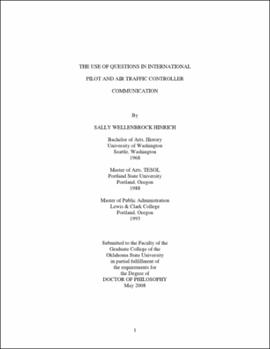| dc.contributor.advisor | Moder, Carol Lynn | |
| dc.contributor.author | Hinrich, Sally Wellenbrock | |
| dc.date.accessioned | 2013-11-26T08:29:33Z | |
| dc.date.available | 2013-11-26T08:29:33Z | |
| dc.date.issued | 2008-05 | |
| dc.identifier.uri | https://hdl.handle.net/11244/7069 | |
| dc.description.abstract | Scope and Method of Study: Discourse analysis examines features of spoken interaction between the speaker and listener. In questioning, the function of the utterance is to obtain a verbal response from the listener addressing new or additional information as requested by the speaker. Thus, questions serve as a "problem-solving tool" to efficiently supply information in interactional situations (Goody, 1978). However, in certain formulaic or restricted languages, forms of questioning may be highly constrained. Aviation phraseology uses a limited glossary of command-based instructions and responses that restricts requests for information to the phrase "say again" spoken with minimal declarative intonation (ICAO, 2001). In contrast, transcripts of daily aviation transmissions exhibit non-phraseology variations that show substantial use of interrogative clauses and declarative clauses with interrogative intonation. This research study applies discourse analysis to a corpus of aviation communication to investigate the types of syntactic, semantic and pragmatic features used to express a questioning function. For this study, over 24 hours of routine aviation messages broadcast from Toronto and Dublin were recorded, transcribed and analyzed for utterances doing questioning. | |
| dc.description.abstract | Findings and Conclusions: Analysis showed that questions occurred more than 28 times per hour in the aviation corpus. The questions employed common interrogative forms, including WH-, YES/NO-, and ALTERNATIVE-questions and items with various pragmatic markers. In addition, more than 42% of the questioning functions occurred in declarative structures that incorporated rising intonation, generally associated with questioning. These findings indicate that both pilots and controllers depend on general question forms for successful interaction despite the fact that these forms are not approved for aviation communication. The results also demonstrate that even in restricted environments, aviation speakers employ general questioning forms as a valuable resource for interaction, and pragmatic features in questioning, including intonation and politeness markers, prove to be an effective tool for aviation communication. | |
| dc.format | application/pdf | |
| dc.language | en_US | |
| dc.rights | Copyright is held by the author who has granted the Oklahoma State University Library the non-exclusive right to share this material in its institutional repository. Contact Digital Library Services at lib-dls@okstate.edu or 405-744-9161 for the permission policy on the use, reproduction or distribution of this material. | |
| dc.title | Use of questions in international pilot and air traffic controller communication | |
| dc.contributor.committeeMember | Halleck, Gene B. | |
| dc.contributor.committeeMember | Sheorey, Ravi | |
| dc.contributor.committeeMember | Van Delinder, Jean | |
| osu.filename | Hinrich_okstate_0664D_2756 | |
| osu.accesstype | Open Access | |
| dc.type.genre | Dissertation | |
| dc.type.material | Text | |
| thesis.degree.discipline | English | |
| thesis.degree.grantor | Oklahoma State University | |
